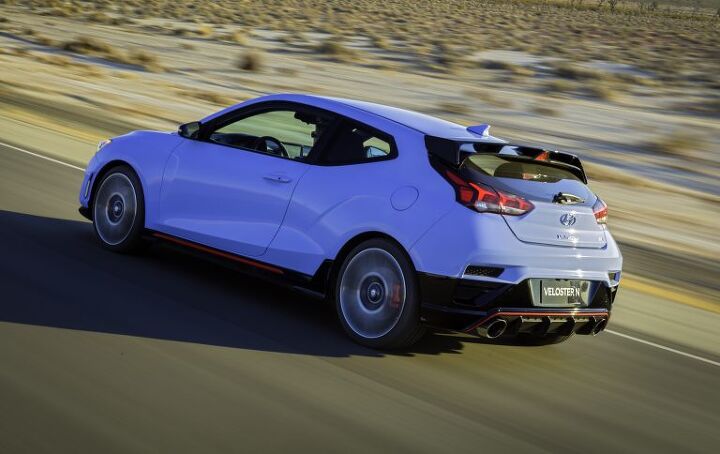Hyundai's 2021 Veloster Comes in Three Flavors, but North of the Border, It's a Very Different Story

The Hyundai Veloster remains an automotive oddity in a vehicle landscape rapidly shunning nonconformity, and for that, we give Hyundai credit. The car still exists. You author can still recall the first time he ever encountered one in the wild — in historic Vieux-Québec, with the “three-door” hatchback resting quietly under a streetlamp on those cobblestone streets.
A second-generation model landed in the latter part of 2018, with newfound power coming by way of the first N-badged Hyundai. With 250 horses and 260 lb-ft of torque, the Veloster N was a vehicle worthy of the hot hatch banner. And come 2021, it’ll be the only Veloster offered north of the border.
As reported by Driving, the base and mid-level Velosters will disappear from Canadian dealerships for the upcoming model year. That means buyers will no longer have the choice to outfit their oddball hatch with a fairly tepid entry-level 2.0-liter (147 hp, 132 lb-ft) or stouter 1.6-liter turbo (201 hp, 195 lb-ft).
In Canada, the Veloster will only exist to enhance the brand’s performance cred. And performance buyers shall receive, as the 275 hp Performance Package becomes standard for the coming year.
Reasons? Hyundai isn’t saying, but one needs only look at the model’s sales figures to guess why. In all of 2019, Hyundai Canada sold just 1,420 Velosters. Compare that to the model’s debut year, where 5,741 Canucks lined up to look offbeat — and that was in the absence of any N-derived heat. In the first seven months of 2020, Veloster sales amounted to just 572 vehicles.
With an eight-speed dual-clutch automatic arriving for 2021, the hottest of Hyundai’s hatches opens itself up to buyers who never wanted, or never learned, to row their own. Sadly, the elimination of the lower-end Veloster comes at the same time as two other discontinuations in that northern market. The Accent, available only in five-door hatch form in Canada, vanishes from that market come 2021 (the sedan-only model remains in the U.S.), and the same goes for the Elantra GT in North America as a whole.
The latter model was available in turbocharged N Line guise, replacing the identically-equipped Sport model. Replacing all of these affordable hatchbacks? An affordable crossover of diminutive proportions (and power). For an automotive brand that introduced itself to the North American market through its hatchbacks, Hyundai seems to want to get rid of them in a hurry.
[Images: Hyundai]

More by Steph Willems
Latest Car Reviews
Read moreLatest Product Reviews
Read moreRecent Comments
- Jeff Maybe one day automatic braking will be better sorted out but as others have stated there are too many false alarms and those false alarms could get one rear ended. I agree about the tire pressure monitoring systems when the batteries go out on the sensors they don't work and they are never meant to last forever. Just buy a good tire gauge and learn how to check the tire pressure and put air in your tires.
- Carson D The funding is so they can travel to China to find manufacturers for their parts.
- Carson D 1996 OBD-II was a good set of regulations. Everything after that has been a net negative.
- ABC-2000 I just got a 2024 Crosstrek, first car for me that require 6000 K or 6 month service, I have been told I better follow that schedule if i actually want to keep it.In the last consumer reports survey, it was the only car that got 99 points for reliability, let's hope they are right (:-)
- Jeff I am going to agree with Tim knobs and buttons but I realize that is low tech but much safer than scrolling thru a screen to reset your interior temperature or to turn off the radio. Also bring back the mechanical parking brake instead of the electronic one.



































Comments
Join the conversation
I saw a current generation Veloster a couple weeks ago and noticed it seemed a bit bigger than the last. Is my memory correct in that they used the same, or similar, platform as the Elantra this year versus the first generation riding on the Accent's platform, or a related platform?
What subcompacts are left? Spark, Rio, Versa, Accent? In Canada the problem is the value of the dollar. How can Nissan or GM make any money selling $10,000 cars - or 7500 US $ ?